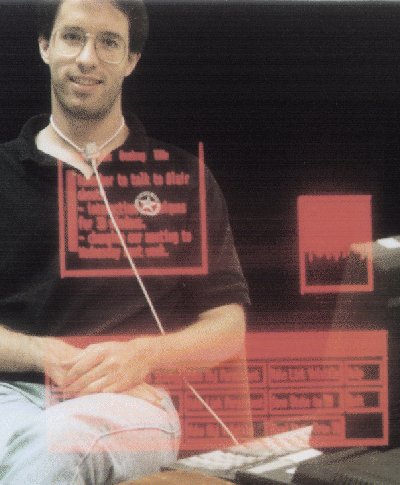Windows on the World |
2D Windows for 3D Augmented RealitySteven Feiner, Blair MacIntyre, Marcus Haupt, Eliot Solomon |

|
Windows on the World |
2D Windows for 3D Augmented RealitySteven Feiner, Blair MacIntyre, Marcus Haupt, Eliot Solomon |

|
We have developed support for a full X11 window system server within our augmented reality testbed. The user wears a see-through head-mounted display, which is tracked so that the display indexes into a large X bitmap. This effectively places the user inside a display space that is mapped onto part of a surrounding virtual sphere. By tracking the user's body, and interpreting head motion relative to it, we create a portable information surround that envelopes the user as they move about. We support three kinds of windows implemented on top of the X server: windows fixed to the head-mounted display, windows fixed to the information surround, and windows fixed to locations and objects in the 3D world. Objects can also be tracked, allowing windows to move with them. To demonstrate the utility of this model, we have developed a small hypermedia system that allows links to be made between windows and windows to be attached to objects. Thus, our hypermedia system can forge links between any combination of physical objects and virtual windows.
 Windows on the World
Windows on the World
The figure shows a virtual world populated by three X windows, photographed ``live'' through our see-through head-mounted display. The window at the right is an xload load-average meter that is fixed to the corner of a portable workstation. The xpostit window at the upper left is attached to the 3D tracker ``bolo tie'' being worn by Blair MacIntyre, so it moves when he moves. The window at the bottom is the control panel for our hypermedia system. It is fixed to the head-mounted display, so it always occupies the same location relative to the user's head.
Columbia University Computer Graphics and User Interfaces Lab